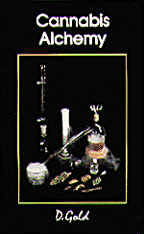
Cannabis Alchemy
by D.Gold
Fractional Distillation
Fractional distillation of the oil requires that the oil be heated to a high temperature under a reduced pressure created by a vacuum pump. This causes the THC and related cannabinoid substances to vaporize. The vapors are condensed back into an oil on contact with a cooled surface.
The desired fraction is collected by selecting the appropriate temperature and pressure for the distillation. Many of the impurities do not vaporize and are left behind in the flask used for heating the oil. The following is a description of a laboratory method for refinement of crude red oil and purified red oil from the basic extract. The work was done by Roger Adams in 1940 and appears on page 198 of volume 62 of the Journal of the American Chemistry Society.
Wild hemp, grown in Minnesota during the season of 1938, was used in the following experiments. The hemp plants were cut after flowering had begun but before seed had set in the female tops; they were stored in a room for six weeks to dry out. A fan was used for circulation and no molding was evident. One-third of the dry hemp plants amounted to stems. These were held and shaken to remove the leafy part of the plant. This clean marijuana was extracted with 95% pure ethyl alcohol. The methods of extraction are described below. Four twenty-gallon crocks, each with a capacity of 23 pounds of material, were arranged for countercurrent extraction. Each crock held 61 liters of solvent, of which 40 were withdrawn at each transfer, with 20 liters being retained by the cannabis. After the process had become uniform, the extract of crock #4 at each transfer held approximately 2 gm of solids per 100 cc. Transfers were made once or twice a day as necessary. The most concentrated extract obtained in this manner was passed to a concentrator, where most of the solvent was flashed off under vacuum. Never was the temperature raised above 50°C. The evaporation was carried out at 30°C. The concentrated solution contained 23.1 gm of solids per 100 cc 95% ethanol, and each 1 cc represented 4.13 gm of hemp.
The red oil from these extracts was obtained by the following methods: ethanolic extract was poured into a 1-liter Claisen flask with a short, wide neck and filled with glass wool until the flask was twothirds full. The temperature of the bath was
raised gradually from 90° to 140°C as the pressure was diminished slightly. The distilled ethanol was discarded, and the flask was again filled to two-thirds capacity. This process was repeated until 1600 cc of extract had been added and the alcohol removed. The temperature was then raised to 200°C, and when the last traces of ethanol ceased, the bath was lowered to 180°C and the pressure reduced to 30 mm. Care was necessary to prevent the liquid from foaming over. The temperature was raised gradually to 200°C until distillation ceased.
The bath was then cooled to 170°C and the pressure reduced to 2-5 mm. The residual product was then distilled. Much care was necessary to keep the bath at the lowest temperature at which the oil distilled evenly, since there was a marked tendency to foam. The material distilled at between 100° and 220°C (3 mm) with the bath temperature at 170—310°C. Yield 180—200 gm crude red oil.
This product was dissolved in 500 cc 30—60°C b.p. petroleum ether and extracted several times with water. The ether layer was distilled and the residue fractionated through a good column having an outside heating unit. The first fraction boiled at 115—120°C and gave a yield of 70—80 gm. The second fraction distilled at 150—175°C, yielding 25—30 gm. The material remaining in the flask was removed by dissolving in ethanol and filtering from the glass wool. The ethanol was evaporated and the product distilled from a 250 cc flask, b.p. 175—195°C (2 mm). Bath temperature was 220—270°C. Yield 90—110 gm purified red oil.

